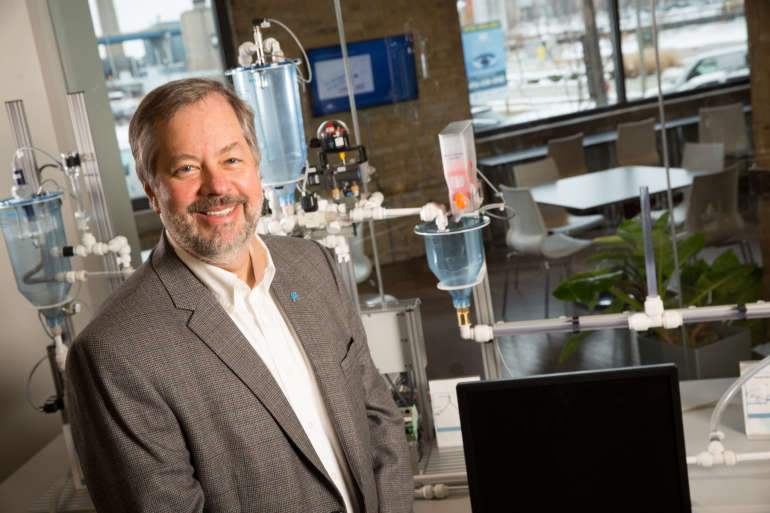The Water Council plans to target federal laboratories and universities for research ideas with the potential for commercialization as it looks to grow Milwaukee’s role as a hub for the water tech industry.

“There are things that are in that research that could get out to the market place, but it’s not,” said Dean Amhaus, The Water Council’s president and chief executive officer.
The plan is to send consultants into the field “like baseball scouts going out to high school baseball games looking for the new talent,” he said.
“That will be a big defining next point for The Water Council,” Amhaus said.
The organization is also working to restructure its membership structure, offering more at the higher levels in terms of access to ideas and intellectual property, but also cutting prices for the lower end to enhance access for start-ups and smaller companies.
Amhaus said the changes come after The Water Council worked on applying to be an institute in the National Network for Manufacturing Innovation run by the U.S. Commerce Department’s National Institute of Standards and Technology.
During the application process, Amhaus said The Water Council realized the program wasn’t a perfect fit for the organization, but continued with the application. NIST selected The Water Council to submit a full application, but the organization declined, even though being awarded the institute could have meant a jump in funding of $8 million to $10 million a year for the next five years.
For an organization that had revenue of just under $3 million in 2015, Amhaus said the jump would have potentially been problematic.
“We’d rather grow it gradually and steadily,” he said.
The organization has done just that, having $898,000 in revenue in 2011 and $1.5 million in 2013. Revenue jumped in 2014 to $3.5 million after receiving a contract from the U.S. Small Business Administration.
Amhaus said The Water Council has been able to build its revenue with 10 to 12 different sources of funding, but he’d like to see that number double.
One source of revenue, and also expense, has been the creation of the Global Water Center at 247 Freshwater Way. Amhaus said the Global Water Center II building will likely also provide a boost. That building, located at 326-332 W. Florida St., is 30 to 35 percent pre-leased. The goal is to reach 50 percent before beginning renovations.
The organization just wrapped up another one of its funding sources with the conclusion of the ninth annual Water Summit. The 2015 version brought in more than $150,000 for The Water Council and Amhaus said this year’s version, which featured a new format, was also a success.
The new format featured journalist Charles Fishman leading panel discussions on resiliency in health, economics, infrastructure and innovation. Among the themes that emerged from the discussions were the need for communication between water utilities and their customers and the need for unity among all the different branches of the water industry.
“Water still needs a revolution,” Fishman said during remarks at the end of the conference.
Maureen Stapleton, San Diego County Water Authority general manager, challenged the audience to offer more leadership and courage. She said raising rates is not popular, but is necessary to support needed upgrades to infrastructure and other parts of the water system.
“We live in a political environment and we have to accept it,” she said.
Stapleton also said communicating with customers means actively seeking them out and talking with them.
“You can’t expect these mass mailings to do much good,” she said of including information with water bills.
Kevin Shafer, Milwaukee Metropolitan Sewerage District executive director, said that water is often a forgotten resource.
“We’ve forgotten about it because every time you turn on the tap it works, you flush the toilet it goes away and the rivers look okay,” he said.
Still, the Flint, Michigan, water contamination crisis was a frequent point of discussion. Magda Peck, founder of MP3 Health Group, said what happens when there is a failure is important, “because technologies inevitably will fail at some point.”
Joel Beauvais, U.S. Environmental Protection Agency deputy assistant administrator for the office of water, said those who work on policy or the business side of water know the challenges facing the country, but others aren’t aware.
He said many people follow issues as they come into the headlines, whether that is water scarcity in California or contamination in Flint.
“In a sense you have to latch on to the fact that something is bringing it into consciousness and then you kind of have to broaden it out,” he said.
Beauvais added that Milwaukee is becoming preeminent in the industry and it is great to be able to point to an ecosystem of business, academia, non-profits and government as an example.
“I think everybody is aware of Milwaukee as representing a center of excellence in the regard, not just nationally, but internationally,” he said.